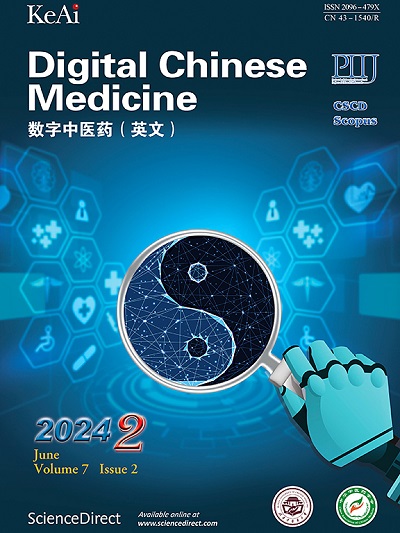Modulation of synaptic damage by Bushen Tiansui Decoction via the PI3K signaling pathway in an Alzheimer’s disease model
Q3 Medicine
引用次数: 0
Abstract
Objective
To explore the therapeutic effect and mechanism of Bushen Tiansui Decoction (补肾填髓方, BSTSD) and its active component icariin on Alzheimer’s disease (AD).
Methods
(i) Animal experiments. This study conducted experiments using specific pathogen-free (SPF) grade male C57BL/6J wild-type (WT) mice and APP/PS1 double transgenic mice. The animals were divided into three groups: WT group (WT mice, n = 5, receiving distilled water daily), APP/PS1 group (APP/PS1 double transgenic mice, n = 5, receiving distilled water daily), and BSTSD group [APP/PS1 double transgenic mice, n = 5, treated with BSTSD suspension at a dosage of 27 g/(kg·d) for 90 d]. Cognitive function was assessed using the Morris water maze (MWM). Post-experiment, hippocampal tissues were collected for analysis of pyramidal cell and synaptic morphology through hematoxylin-eosin (HE) staining and transmission electron microscopy (TEM). (ii) Cell experiments. The HT-22 cells were divided into control group (untreated), Aβ25-35 group (treated with 20 μmol/L Aβ25-35 for 24 h), icariin group (pre-treated with 20 μmol/L icariin for 60 min, followed by 20 μmol/L Aβ25-35 for an additional 24 h), and icariin + LY294002 group [treated with 20 μmol/L icariin and 20 μmol/L LY294002 (an inhibitor of the phosphoinostitide 3-kinases (PI3K) signaling pathway) for 60 min, then exposed to 20 μmol/L Aβ25-35 for 24 h], and cell viability was measured. Western blot was used to detect the expression levels of synapse-associated proteins [synaptophysin (SYP) and postsynaptic density-95 (PSD-95)] and PI3K signaling pathway associated proteins [phosphorylated (p)-PI3K/PI3K, p-protein kinase B (Akt)/Akt, and p-mechanistic target of rapamycin (mTOR)/mTOR].
Results
(i) Animal experiments. Compared with APP/PS1 group, BSTSD group showed that escape latency was significantly shortened (P < 0.01) and the frequency of crossing the original platform was significantly increased (P < 0.01). Morphological observation showed that pyramidal cells in the hippocampal CA1 region were arranged more regularly, nuclear staining was uniform, and vacuole-like changes were reduced after BSTSD treatment. TEM showed that the length of synaptic active zone in BSTSD treatment group was increased compared with APP/PS1 group (P < 0.01), and the width of synaptic gap was decreased (P < 0.01). (ii) Cell experiments. Icariin had no obvious toxicity to HT-22 cells when the concentration was not more than 20 μmol/L (P > 0.05), and alleviated the cell viability decline induced by Aβ25-35 (P < 0.01). Western blot results showed that compared with Aβ25-35 group, the ratios of p-PI3K/PI3K, p-Akt/Akt and p-mTOR/mTOR in icariin group were significantly increased (P < 0.01), while the protein expression levels of SYP and PSD-95 were increased (P < 0.01). These effects were blocked by LY294002 (P < 0.01).
Conclusion
BSTSD and icariin enhance cognitive function and synaptic integrity in AD models and provide potential therapeutic strategies through activation of the PI3K/Akt/mTOR pathway.
补肾天遂汤通过PI3K信号通路调节阿尔茨海默病模型的突触损伤
目的探讨补肾天遂汤及其有效成分淫羊藿苷对阿尔茨海默病(AD)的治疗作用及机制。方法(1)动物实验。本研究采用SPF级雄性C57BL/6J野生型(WT)小鼠和APP/PS1双转基因小鼠进行实验。将动物分为三组:WT组(WT小鼠,n = 5,每天接受蒸馏水)、APP/PS1组(APP/PS1双转基因小鼠,n = 5,每天接受蒸馏水)和BSTSD组[APP/PS1双转基因小鼠,n = 5,以27 g/(kg·d)的剂量给予BSTSD混悬液,持续90 d]。采用Morris水迷宫(MWM)评估认知功能。实验结束后,采集海马组织,通过苏木精-伊红(HE)染色和透射电镜(TEM)分析锥体细胞和突触形态。(ii)细胞实验。HT-22细胞分为对照组(治疗),一个β25 - 35组(治疗20μmol / L的β25 - 24 h), icariin集团(预处理与20μ,淫羊藿60分钟浓度mol / L,紧随其后的是20μmol / Lβ25 - 35一个额外的24 h),淫羊藿+ LY294002浓度和组(治疗20μ,淫羊藿和20μ摩尔浓度mol / L / L LY294002(抑制剂phosphoinostitide 3-kinases PI3K信号通路)60分钟,然后暴露于20μmol / L的β25 - 24小时),和细胞生存能力测量。Western blot检测突触相关蛋白[synaptophysin (SYP)和突触后密度-95 (PSD-95)]和PI3K信号通路相关蛋白[磷酸化(p)-PI3K/PI3K, p蛋白激酶B (Akt)/Akt和雷帕霉素p-mechanistic target of rapamycin (mTOR)/mTOR]的表达水平。与APP/PS1组比较,BSTSD组小鼠逃避潜伏期显著缩短(P <;0.01),穿越原平台的频率显著增加(P <;0.01)。形态学观察显示,BSTSD处理后海马CA1区锥体细胞排列更加规则,细胞核染色均匀,空泡样改变减少。透射电镜显示,与APP/PS1组相比,BSTSD治疗组突触活性区长度增加(P <;0.01),突触间隙宽度减小(P <;0.01)。(ii)细胞实验。当淫羊藿苷浓度不大于20 μmol/L时,对HT-22细胞无明显毒性作用(P >;0.05),并减轻了Aβ25-35诱导的细胞活力下降(P <;0.01)。Western blot结果显示,与Aβ25-35组相比,淫羊藿苷组P -PI3K/PI3K、P -Akt/Akt、P -mTOR/mTOR比值显著升高(P <;0.01),而SYP和PSD-95蛋白表达水平升高(P <;0.01)。LY294002 (P <;0.01)。结论bstsd和淫羊藿苷可增强AD模型的认知功能和突触完整性,并通过激活PI3K/Akt/mTOR通路提供潜在的治疗策略。
本文章由计算机程序翻译,如有差异,请以英文原文为准。
求助全文
约1分钟内获得全文
求助全文
来源期刊

Digital Chinese Medicine
Medicine-Complementary and Alternative Medicine
CiteScore
1.80
自引率
0.00%
发文量
126
审稿时长
63 days
期刊介绍:
 求助内容:
求助内容: 应助结果提醒方式:
应助结果提醒方式:


